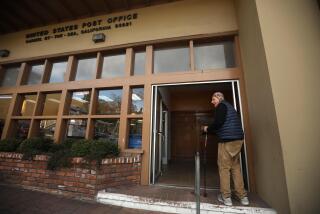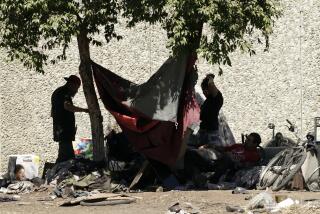Census Bureau Counting on Sacramento Test
- Share via
SACRAMENTO — For a rather sleepy, dust-in-your-shoes farm town that couldn’t so much as attract a major league baseball team, the state capital might seem an unlikely candidate for an assignment that will help determine the future of 270 million Americans.
But in just two years, the Census Bureau faces the staggering task of counting the nation’s population, and federal officials have chosen Sacramento as the urban test kitchen for the most innovative and controversial census in 200 years.
At this very moment, the people of Sacramento are being counted in one of only three sites in the nation chosen for a dress rehearsal designed to get the bugs out before the real thing in 2000. And it is the only place that will test a new counting method so controversial and politically divisive it has regularly tied up Congress in knots.
The rehearsal began a month ago and has taken over the town. Advertising encouraging Sacramentans to fill out the form dominates TV and radio airwaves. Little rolling billboards cruise the streets, warning in five languages: “Don’t Leave Your Future Blank.”
Fifty census assistance offices staffed by people fluent in Russian, Thai, Tagalog, Spanish or Hmong have popped up in a city that is one of the most ethnically diverse in the country, even if it is only 96 miles square. Literature pours through the mail slots--a notice that the census form will be coming, the form itself, a reminder to fill out the form, a thank-you note for filling out the form and a second form in case you lost the first one.
“Half a forest must have been felled” on Sacramento, one resident noted. “I’ve never seen so much paper.”
Never has the federal government seemed so efficient; letters dated March 27 were arriving on March 22. By the time it all ends in August, the Census Bureau will have provided 2,000 temporary jobs paying as much as $15.50 an hour, with at least dozens of those positions going to people coming off of welfare, officials said.
Although the census process itself seems bureaucratic and obscure, an accurate count helps determine everything from how a state is represented in Washington to where the future kindergartens and shopping malls will be built. It provides a snapshot of the most homogeneous nation on the globe and determines how billions of federal dollars will be divvied up among states in the next century.
But that message has been increasingly lost on residents in recent years as much of America became too busy, or destitute, to be counted and census questionnaires were lost in a growing stack of junk mail.
Fighting Decline in Response Rate
Faced with a steadily declining response rate, census officials have come up with some first-ever strategies they hope will motivate America to fill out the form in 2000. And the guinea pigs are the people of urban Sacramento--along with 11 counties around Columbia, S.C., selected as the rural site, and the Menominee Indian reservation in Wisconsin, chosen because the Native American population has been one of the most seriously undercounted.
That Sacramento was tapped as the urban testing ground seems to fly in the face of the city’s backwater image. A farm community that longs to be a world-class capital, Sacramento recently renamed its airport Sacramento International and hoped nobody would notice that there weren’t any direct foreign flights. Still, people joked that a big night in Sacramento isn’t going out to a movie, it’s renting a video.
But the census bureau saw through all that, seizing on Sacramento’s eclectic sampling of ethnic groups--Hispanic, African American, Chinese, Vietnamese, Russian, Thai, Filipino, Hmong--allowing demographers to test their methods on minority populations that have been sorely undercounted in the past.
The state capital also has a nicely self-contained, reasonably priced media market perfect for trying out an unprecedented $100-million Madison Avenue campaign planned for the year 2000 that will take the place of middle-of-the-night free public service announcements of the past.
Sleek new questionnaires are designed to be cleaner and easier to decipher; short forms once only available by mail are now in Sacramento’s churches, libraries and liquor stores; and telephone hotlines are ready to answer questions.
A census festival with live multicultural entertainment was held Saturday--the official Census Day--to help get people in the mood. (But a bigger draw five blocks away appeared to be a giveaway of free food at Capitol Park, which attracted thousands.)
Still, it all seems to be working. Since forms were sent out on March 14 to 173,000 households, more than one-third have already come back, apparent testament to the effectiveness of prime-time saturation advertising, officials said.
“It’s everywhere,” state Capitol staffer Patricia Wynne said of the public relations campaign. Usually a procrastinator, she filled out her form the day she got it. “The way it is presented in the advertising, participation is almost a commitment to your community. It’s almost a civic responsibility.”
As straws in the wind go, that’s encouraging, particularly for a census bureau that watched the 1980 mail response of 75% slide to 65% in 1990, helping make that the most inaccurate census on record.
Much of the problem stems from social changes that made traditional counting methods obsolete, a growing immigrant population and more working women.
“In the old days, Ozzie went to the office and Harriet stayed home and filled out the census form and took a job as an enumerator,” one census official said. “Now Harriet’s at work and frantic when she gets home. Ozzie, if he hasn’t been downsized, is working harder and we’ve been on a slide in terms of mail-back participation.”
Even with all the early responses in Sacramento’s tryout, the hard part has yet to begin. In mid-May, enumerators will start knocking on doors in an attempt to count the hard-to-reach populations: those who don’t understand the form, who hate the government or won’t answer the mail, who live in garages or trailers without addresses or are homeless altogether.
Long a problem for demographers and the cause of a whopping 1.6% national undercount in 1990, the uncounted this time will be estimated statistically by directly counting 90% of the people in each census tract and using that data to estimate the remaining 10%.
Sacramento is the only one of the three test sites where that method--known as statistical sampling--will be tried, making it the laboratory for a technique that has made this census among the most controversial since George Washington ordered the first one in 1791.
Sampling has divided Congress and spawned two lawsuits, one by House Speaker Newt Gingrich himself. It is the reason funding was held up for the dress rehearsals, causing advertisers to rush their campaigns and forcing the Census Bureau to conduct two different trials--with sampling in Sacramento and without it in South Carolina and Wisconsin.
Controversial Sampling Method
Sampling opponents, primarily Republicans, contend that every person in America should be physically counted. Proponents, including the National Academy of Sciences and most Democrats, hold that is no longer possible.
In a nation this large, enumerators eventually are reduced to asking a neighbor or mail carrier to fill in the blanks about people they simply cannot reach, a last resort that critics consider highly unreliable. And with the nation’s low unemployment rate, some question whether enough qualified people could be found to go out and do the counting.
The statistical community will be closely watching the process in Sacramento--but no more so than Congress, which will rely on the results to determine whether sampling should be used in Census 2000. If it is employed, traditionally undercounted California stands to gain as much as $1 billion in added federal dollars over the next decade, state officials estimate. Nearly 1 million Californians were missed in 1990, the census bureau has reported, primarily because of the state’s large population of minorities and urban poor who are among the hardest to count.
Mayor Joe Serna knows well that his city is under a national microscope and is encouraging residents to give it their all. “We just want to make sure we don’t experience another undercount problem,” he said. “An accurate census is critical to communities like Sacramento because it translates to financial support.”
Much like the city that hosts the Olympics and gets a few new stadiums in return, Sacramento stands to reap substantial benefits for permitting the census to stretch its legs there.
First, it has the prestige of helping carry out a mandate prescribed by the forefathers themselves. But more importantly, it will get a stack of data two years earlier than the rest of the country, an invaluable tool for mapping out the city’s future.
“Sacramento will have had an event that provided employment at pretty good wages, and it will get really good solid numbers two years ahead of everyone else,” said Bob Clingman, Census Bureau media partnership specialist.
“And having gone through the entire process, we believe the 2000 Census in Sacramento is going to be a smooth one. We’ll have trained workers who can come back and do it again, and a citizenry that won’t have forgotten how important the function is.”
More to Read
Sign up for Essential California
The most important California stories and recommendations in your inbox every morning.
You may occasionally receive promotional content from the Los Angeles Times.










